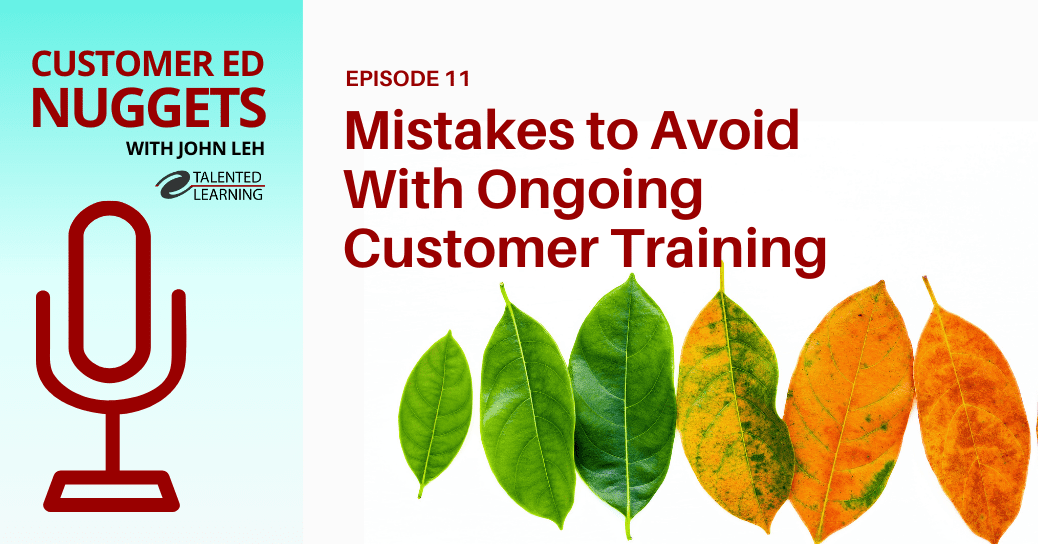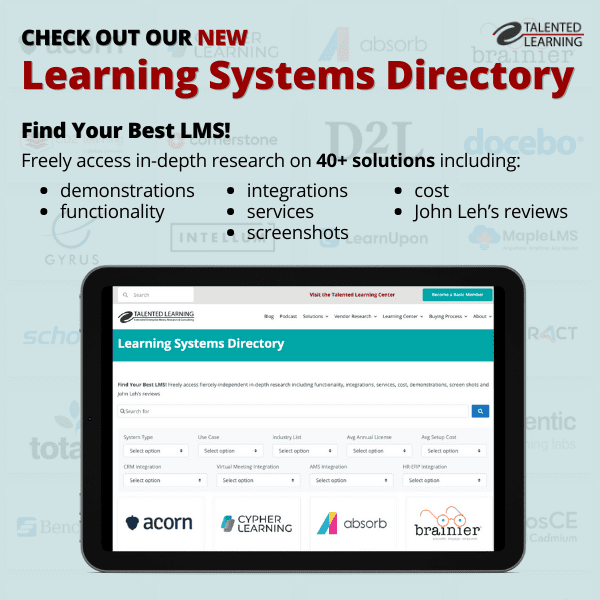
We’re now entering our eighth year of helping extended enterprise buyers choose the best continuing education LMS for their unique needs. But with more than 1000 learning systems to consider, the process remains tricky. To show you what I mean, I’ll describe a typical extended enterprise LMS buying opportunity. Then I’ll ask you to tell me which LMS you would pick.
Let’s start by defining a key term:
What Is “Extended Enterprise” Learning?
Any instructional content intended to help non-employee or non-academic audiences develop knowledge or skill is “extended enterprise” learning. Generally, you’ll find two flavors:
- CORPORATE EXTENDED ENTERPRISE
Businesses use training strategically to drive measurable behavior change among any combination of audiences: customers, partners, and contractors, as well as employees. This kind of training supports core business activities.
- CONTINUING EDUCATION
Among professional associations, training companies, publishers and even individual subject matter experts, creating, selling and distributing instructional content IS the core business.
Whether you’re on the buyer or seller side of an LMS purchasing transaction, it’s important to understand the anatomy of the typical selection process.
To illustrate, let’s look at one scenario, based on my experience with a continuing education provider. (To protect the innocent, we’ve changed the client name to “CE Buyer.”)
Example: Choosing a Continuing Education LMS
Recently I was hired as the learning systems selection consultant for a mature training company in the industrial manufacturing space. After struggling for four years with a well-known cloud-based, multi-tenant LMS, the client was ready for a replacement.
A weak selection process originally led this “CE Buyer” to its existing system – and everyone immediately regretted the choice. The organization fired its LMS selection team and then spent the next three years trying to turn lemons into lemonade. Finally, the team gave up and asked me to help find a more effective solution.
Sad situation, but fairly common among my clients.
Quick Take: What Went Wrong?
When the incoming technical team discovered unforeseen deficiencies in the existing LMS functionality, they decided to leverage other applications to compensate. For instance, they deployed WordPress, Microsoft Dynamics and custom programming to create a new front-end with a unified experience for learners and client administrators. This pushed core LMS functionality to the background, but multiplied the system’s overall complexity, cost and maintenance.
Rather than solving their problems, they soon discovered that APIs published by the LMS vendor were not as robust or reliable as advertised. This caused data bottlenecks that slowed the system and created a need for custom-developed APIs.
To add insult to injury, although the CE Buyer is a large organization, the level of support provided by the LMS vendor was minimal-to-non-existent, and vendor executives were nowhere to be found. By the time this opportunity found me, no one on the 20-member cross-functional team would vouch for that LMS – even a little bit.
An intervention was long over-due. So I led the client through our multi-step process of organization discovery, requirements definition, vendor shortlisting, RFP development, use-case demos, technical discussions, reference checking, proof-of-concept, vendor selection and licensing contract guidance.
Let’s take a closer look at the company and requirements below. Then you can try your hand at my job and recommend a vendor solution.
“CE Buyer” Business Overview
For decades, this for-profit training company has created and delivered certification content to employees and B2B audiences – originally through classroom training and eventually elearning. Its business footprint has grown from regional to national, and now international reach. Along the way, it has cycled through a series of LMSs, as well as LMS owners.
This company’s customers are vocational tech schools, universities and manufacturing corporations of all sizes and types around the globe. In all, this provider serves 35,000 customer organizations, each with 2-100+ learners. And each year, about 175,000 unique learners log-in to the LMS 8-10 times on average, where they consume instructional content from hundreds of options.
This training company has 250+ employees dedicated to creating, selling, delivering and supporting its learning content. In 2019, its content revenues totaled more than $30 million. That’s a hefty continuing education LMS project!
Buyer Stakeholder Team
With continuing education LMS opportunities, the stakeholder group often includes representatives from many different functions. When content is your business, everyone is involved.
To avoid selection missteps and encourage full buy-in, this CE Buyer opted for a “big tent” approach, including representatives Research and Development, Product Development, Delivery, IT and Marketing.
Existing Content Strategy
Over time, this CE Buyer has developed a series of learning tracks for key user roles. Tracks feature 4-5 levels, each with a personalized sequence of microlearning content items. These items include videos, PDF documents, games, SCORM 1.2 and 2004 modules that have been authored externally, private and public ILT/VILT, knowledge assessments and OJT activities.
For learners to complete tracks and prove their competence, they must demonstrate skills to instructors or managers or submit a video for approval.
Certification Strategy
To obtain individual certification, learners are guided through a relevant training track. When a predefined % of a customer’s employees are certified, the entire organization is eligible to receive certification.
Certification is attractive to manufacturing organizations served by the CE Buyer because it helps differentiate these companies in the marketplace. It also helps them win more business because they can more easily participate in project estimates and bids.
Existing Technical Ecosystem
When selecting a new continuing education LMS, it’s important to define the existing technical ecosystem needed to support the business. This can be challenging, but it’s essential to clarify precisely what stays and what goes when a new LMS is introduced.
Specifically, what will the LMS do, compared with other systems? How will data flow? And what exactly will change about the learner experience and administrative environment? In this case, the core ecosystem includes:
- A commercially available cloud LMS
- ADP Workforce Now
- Microsoft Dynamics CRM
- GoToWebinar
- Zoom
- Wistia video
- LinkedIn Learning
- Okta Single Sign-On
- DOMO business intelligence software
Pain Points – Why Replace the LMS?
As mentioned previously, the buyer deployed a generic cloud-based LMS four years ago, and subsequently tried to implement advanced integrations with business portals, CRM, email marketing, e-commerce, SSO and various custom-built applications. This patchwork approach is insufficient. Other key deficiencies:
- Due to informal onsite training delivery, ILT tracking of individual learners is inconsistent. There is no easy way to capture non-registered learners who arrive at live events or attend virtual training as a team.
- LMS API integrations were not as strong or deep as the LMS vendor claimed, so tens of thousands of records choke the system and updates can’t be processed in a realistic timeframe.
- Learner experience is inconsistent because it relies on a broader ecosystem journey.
- A lack of advanced B2B e-commerce makes it impossible to facilitate high-volume organizational content sales and ongoing customer self-maintenance.
- Reliance on live instructors isn’t practical or scalable, as a result of the COVID pandemic.
- No remote content distribution solution is available for clients that want access only to content, so they can make it available on their own LMS.
- The existing system lacks detailed, accurate analytics focused on training ROI and business impact among client organizations.
Top 10 Functionality Needs
Functional requirements to support a global B2B training business are unique. In addition to requirements common to all LMS deployments, the buyer has these unique continuing education LMS needs:
- Global platform with English, Spanish, French, German, Korean, Portuguese and Japanese localizations
- Advanced content management functionality
- Intra-LMS content creation tools
- Learning paths and certifications
- B2B e-commerce and organizational customer management
- Social and gamification
- Informal learning
- Restful API integrations with pre-built VILT, CRM and SSO connectors
- Remote content capabilities
- Granular role management
- Webhooks
- Consumer-grade learner interface
Professional Services Needs
This CE Buyer is looking for support throughout planning, implementation, launch and beyond, including:
- Executive sponsor and contact
- Project management
- Implementation plan for all requirements
- Configuration consulting and guidance
- Integration services to design and implement key integrations
- Full data migration
- 40,000 customer organizational records
- 500,000 active and inactive user profiles
- 10,000,000 training completion records
- Full content migration
- 400 SCORM 1.2 and 2004 courses
- 600 Wistia videos
- 100 Virtual and ILT courses
- 75 Learning tracks
- QA and user testing support
- Administrative training
- Comprehensive rollout and improvement support
- Ongoing administrative and end-learner support services.
Who Should I Shortlist?
Whew. Are you still with me? That’s a tall order, but it’s not unusual in my world as an extended enterprise LMS consultant.
Now, I want your recommendation. As this opportunity proceeds into the qualified vendor “shortlist” phase, I’m deliberating about the top 4 vendors that can rise to this challenge.
In the poll below, tell me which continuing education LMS would you consider?
Conclusion
Before continuing education specialists arrived on the LMS scene, buyers in the CE realm had to settle for the best employee or academic learning system they could find. Not anymore.
There’s no need to compromise. If you define your requirements carefully, I guarantee you can find a continuing education LMS that will satisfy your particular needs. But success depends on your willingness to do the research and document your requirements upfront (or let someone guide you through that process).
Thanks for reading!
Share This Post
Related Posts
The Future of Customer Education: Customer Ed Nugget 16
Customer education is rapidly evolving as organizations embrace new strategies and tech. What does this mean for the future of customer education? See what experts say on this Customer Ed Nuggets episode
Education Strategy Mistakes to Avoid: Customer Ed Nugget 15
What does it take to deliver a successful customer education program? It starts with a solid education strategy. Learn how to avoid common pitfalls on this Customer Ed Nuggets episode
Which LMS is Best for You? New Shortlisting Tool for 2024
How can you find the best learning system for your business? Our LMS shortlisting tool can help. Learn about the 2024 RightFit Solution Grid. Free, reliable guidance based on our independent research
How to Build a Learning-Based Business: Executive Q&A Notes
Building and selling online courses may seem easy, but building a profitable learning-based business is far more complex. Find out what successful leaders say about running this kind of business
The Rewards of Community Building: Customer Ed Nugget 14
What role does community play in your customer relationships? Find out why community building is such a powerful force in customer education on this Customer Ed Nuggets episode
Benefits of Training Content Syndication: Customer Ed Nugget 13
If you educate customers online, why should you consider content syndication? Discover 10 compelling business benefits in this Customer Ed Nuggets episode
Top Marketing Skills to Master: Customer Ed Nugget 12
Successful customer education programs depend on professionals with expertise in multiple disciplines. Which marketing skills lead to the best results?
How to Measure and Improve Partner Training ROI
An educated channel is a successful channel. But how do you know if your educational programs are effective? Learn from an expert how to evaluate partner training ROI
Mistakes in Ongoing Customer Training: Customer Ed Nugget 11
Customer education doesn't stop with onboarding. It pays to invest in ongoing customer training. Learn which mistakes to avoid in this Customer Ed Nuggets episode














FOLLOW US ON SOCIAL